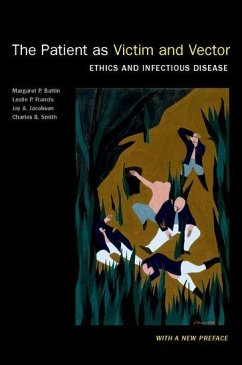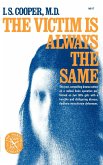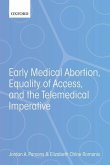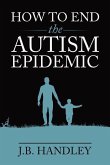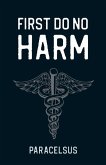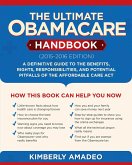- Broschiertes Buch
- Merkliste
- Auf die Merkliste
- Bewerten Bewerten
- Teilen
- Produkt teilen
- Produkterinnerung
- Produkterinnerung
This volume is jointly written by four authors at the University of Utah with expertise in bioethics, health law, and infectious disease. In collaboration they attempt to develop a normative framework sensitive to situations of disease transmission- situations in which the patient is not only a victim but a vector; i.e. vulnerable to disease but also a threat to others. This reissue includes a new preface exploring the implications of the Covid-19 pandemic.
Andere Kunden interessierten sich auch für
![How To Avoid Being a Victim of the American Healthcare System: A Patient's Handbook for Survival How To Avoid Being a Victim of the American Healthcare System: A Patient's Handbook for Survival]() David WilcoxHow To Avoid Being a Victim of the American Healthcare System: A Patient's Handbook for Survival23,99 €
David WilcoxHow To Avoid Being a Victim of the American Healthcare System: A Patient's Handbook for Survival23,99 €![The Victim Is Always the Same The Victim Is Always the Same]() I. S. CooperThe Victim Is Always the Same18,99 €
I. S. CooperThe Victim Is Always the Same18,99 €![The Eradication of Smallpox The Eradication of Smallpox]() Herve BazinThe Eradication of Smallpox114,99 €
Herve BazinThe Eradication of Smallpox114,99 €![Early Medical Abortion, Equality of Access, and the Telemedical Imperative Early Medical Abortion, Equality of Access, and the Telemedical Imperative]() Jordan A ParsonsEarly Medical Abortion, Equality of Access, and the Telemedical Imperative73,99 €
Jordan A ParsonsEarly Medical Abortion, Equality of Access, and the Telemedical Imperative73,99 €![How to End the Autism Epidemic How to End the Autism Epidemic]() J B HandleyHow to End the Autism Epidemic18,99 €
J B HandleyHow to End the Autism Epidemic18,99 €![First Do No Harm First Do No Harm]() ParacelsusFirst Do No Harm22,99 €
ParacelsusFirst Do No Harm22,99 €![The Ultimate Obamacare Handbook (2015-2016 Edition) The Ultimate Obamacare Handbook (2015-2016 Edition)]() Kimberly AmadeoThe Ultimate Obamacare Handbook (2015-2016 Edition)18,99 €
Kimberly AmadeoThe Ultimate Obamacare Handbook (2015-2016 Edition)18,99 €-
-
-
This volume is jointly written by four authors at the University of Utah with expertise in bioethics, health law, and infectious disease. In collaboration they attempt to develop a normative framework sensitive to situations of disease transmission- situations in which the patient is not only a victim but a vector; i.e. vulnerable to disease but also a threat to others. This reissue includes a new preface exploring the implications of the Covid-19 pandemic.
Hinweis: Dieser Artikel kann nur an eine deutsche Lieferadresse ausgeliefert werden.
Hinweis: Dieser Artikel kann nur an eine deutsche Lieferadresse ausgeliefert werden.
Produktdetails
- Produktdetails
- Verlag: Oxford University Press
- 2nd edition
- Seitenzahl: 592
- Erscheinungstermin: 18. Januar 2021
- Englisch
- Abmessung: 234mm x 152mm x 34mm
- Gewicht: 842g
- ISBN-13: 9780197564547
- ISBN-10: 0197564542
- Artikelnr.: 62041351
- Herstellerkennzeichnung
- Libri GmbH
- Europaallee 1
- 36244 Bad Hersfeld
- gpsr@libri.de
- Verlag: Oxford University Press
- 2nd edition
- Seitenzahl: 592
- Erscheinungstermin: 18. Januar 2021
- Englisch
- Abmessung: 234mm x 152mm x 34mm
- Gewicht: 842g
- ISBN-13: 9780197564547
- ISBN-10: 0197564542
- Artikelnr.: 62041351
- Herstellerkennzeichnung
- Libri GmbH
- Europaallee 1
- 36244 Bad Hersfeld
- gpsr@libri.de
Margaret P. Battin, MFA, PhD, is Distinguished Professor of Philosophy and Adjunct Professor of Internal Medicine in the Program in Medical Ethics and Humanities at the University of Utah. The author of prize-winning short stories, she has authored, edited, or co-edited some twenty academic books, including The Least Worst Death. She has been named one of the "Mothers of Bioethics." Leslie P. Francis, PhD, JD, is Distinguished Professor of Philosophy and Distinguished Alfred C. Emery Professor of Law at the University of Utah. She writes on privacy, reproductive ethics, data use in public health, disability law, and federalism, and provides pro bono legal representation to people who are subjected to guardianship proceedings. Her books include Privacy: What Everyone Needs to Know. Jay A. Jacobson, MD, is Emeritus Professor, Division of Infectious Disease and founder of the Division of Medical Ethics and Humanities at the University of Utah School of Medicine. He is a Master of the American College of Physicians and Fellow, Infectious Diseases Society of America. He is a recipient of the American Medical Association Award for Leadership in Medical Ethics and Professionalism. Charles B. Smith, MD, is Emeritus Professor of Medicine at the University of Utah School of Medicine and previous Chief of the Division of Infectious Diseases. He has been Associate Dean at the University of Washington School of Medicine and Chief Medical Officer at the Seattle Veterans Administration Hospital. He has served as President of the Veterans Administration Association of Chiefs of Staff and is co-editor of Ethics and Infectious Disease.
* Preface: Victims, Vectors, and the COVID-19 Pandemic
* Part I: Seeing Infectious Disease as Central
* 1. Seeing Infectious Disease as Central
* 2. The Biological Basics of Infectious Disease
* 3. Characteristics of Infectious Disease that Raise Distinctive
Challenges for Bioethics
* 4. How Infectious Disease Got Left Out of Bioethics
* 5. Closing the Book on Infectious Disease: The Mischievous
Consequences for Public Health
* Part II: Theoretical Considerations
* 6. Embedded Autonomy and the "Way-Station Self"
* 7. Thinking about Infectious Disease: The Multiple Perspectives of
the PVV View
* Part III: Dilemmas Old and New: Health Care Dilemmas Through the Lens
of Infectious Disease
* 8. Old Wine in New Bottles: Traditional Issues in Bioethics from the
Victim/Vector Perspective
* 9. From the Magic Mountain to a Dying Homeless Man and His Dog:
Imposing Isolation and Treatment in Tuberculosis Care
* 10. The Ethics of Research in Infectious Disease: Experimenting on
This Patient, Risking Harm to That One
* 11. Vertically-Transmitted Infection: Are the Medical and Public
Health Responses Consistent?
* 12. Should Rapid Tests for HIV Infection Now Be "Mandatory" During
Pregnancy or in Labor?
* 13. Antimicrobial Resistance
* 14. Immunization and the HPV Vaccine
* Part IV: Constraints and the Question of What We Owe Each Other As
Victims and Vectors
* 15. A Thought Experiment: Rapid Testing for Infectious Disease in
Airports and Places of Public Contact
* 16. Constraints in the Control of Infectious Disease
* 17. Pandemic Planning: What is Ethically Justified?
* 18. Compensation and the Victims of Constraint
* 19. Pandemic Planning and the Justice of Health Care Distribution
* Part V: Making Use of the PVV View
* 20. Thinking Bi: Emerging Global Efforts for the Control of
Infectious Disease
* 21. "The Patient as Victim and Vector" Approach as a Critical and
Diagnostic Tool for Philosophical Ethics and Public Policy
* References.
* Part I: Seeing Infectious Disease as Central
* 1. Seeing Infectious Disease as Central
* 2. The Biological Basics of Infectious Disease
* 3. Characteristics of Infectious Disease that Raise Distinctive
Challenges for Bioethics
* 4. How Infectious Disease Got Left Out of Bioethics
* 5. Closing the Book on Infectious Disease: The Mischievous
Consequences for Public Health
* Part II: Theoretical Considerations
* 6. Embedded Autonomy and the "Way-Station Self"
* 7. Thinking about Infectious Disease: The Multiple Perspectives of
the PVV View
* Part III: Dilemmas Old and New: Health Care Dilemmas Through the Lens
of Infectious Disease
* 8. Old Wine in New Bottles: Traditional Issues in Bioethics from the
Victim/Vector Perspective
* 9. From the Magic Mountain to a Dying Homeless Man and His Dog:
Imposing Isolation and Treatment in Tuberculosis Care
* 10. The Ethics of Research in Infectious Disease: Experimenting on
This Patient, Risking Harm to That One
* 11. Vertically-Transmitted Infection: Are the Medical and Public
Health Responses Consistent?
* 12. Should Rapid Tests for HIV Infection Now Be "Mandatory" During
Pregnancy or in Labor?
* 13. Antimicrobial Resistance
* 14. Immunization and the HPV Vaccine
* Part IV: Constraints and the Question of What We Owe Each Other As
Victims and Vectors
* 15. A Thought Experiment: Rapid Testing for Infectious Disease in
Airports and Places of Public Contact
* 16. Constraints in the Control of Infectious Disease
* 17. Pandemic Planning: What is Ethically Justified?
* 18. Compensation and the Victims of Constraint
* 19. Pandemic Planning and the Justice of Health Care Distribution
* Part V: Making Use of the PVV View
* 20. Thinking Bi: Emerging Global Efforts for the Control of
Infectious Disease
* 21. "The Patient as Victim and Vector" Approach as a Critical and
Diagnostic Tool for Philosophical Ethics and Public Policy
* References.
* Preface: Victims, Vectors, and the COVID-19 Pandemic
* Part I: Seeing Infectious Disease as Central
* 1. Seeing Infectious Disease as Central
* 2. The Biological Basics of Infectious Disease
* 3. Characteristics of Infectious Disease that Raise Distinctive
Challenges for Bioethics
* 4. How Infectious Disease Got Left Out of Bioethics
* 5. Closing the Book on Infectious Disease: The Mischievous
Consequences for Public Health
* Part II: Theoretical Considerations
* 6. Embedded Autonomy and the "Way-Station Self"
* 7. Thinking about Infectious Disease: The Multiple Perspectives of
the PVV View
* Part III: Dilemmas Old and New: Health Care Dilemmas Through the Lens
of Infectious Disease
* 8. Old Wine in New Bottles: Traditional Issues in Bioethics from the
Victim/Vector Perspective
* 9. From the Magic Mountain to a Dying Homeless Man and His Dog:
Imposing Isolation and Treatment in Tuberculosis Care
* 10. The Ethics of Research in Infectious Disease: Experimenting on
This Patient, Risking Harm to That One
* 11. Vertically-Transmitted Infection: Are the Medical and Public
Health Responses Consistent?
* 12. Should Rapid Tests for HIV Infection Now Be "Mandatory" During
Pregnancy or in Labor?
* 13. Antimicrobial Resistance
* 14. Immunization and the HPV Vaccine
* Part IV: Constraints and the Question of What We Owe Each Other As
Victims and Vectors
* 15. A Thought Experiment: Rapid Testing for Infectious Disease in
Airports and Places of Public Contact
* 16. Constraints in the Control of Infectious Disease
* 17. Pandemic Planning: What is Ethically Justified?
* 18. Compensation and the Victims of Constraint
* 19. Pandemic Planning and the Justice of Health Care Distribution
* Part V: Making Use of the PVV View
* 20. Thinking Bi: Emerging Global Efforts for the Control of
Infectious Disease
* 21. "The Patient as Victim and Vector" Approach as a Critical and
Diagnostic Tool for Philosophical Ethics and Public Policy
* References.
* Part I: Seeing Infectious Disease as Central
* 1. Seeing Infectious Disease as Central
* 2. The Biological Basics of Infectious Disease
* 3. Characteristics of Infectious Disease that Raise Distinctive
Challenges for Bioethics
* 4. How Infectious Disease Got Left Out of Bioethics
* 5. Closing the Book on Infectious Disease: The Mischievous
Consequences for Public Health
* Part II: Theoretical Considerations
* 6. Embedded Autonomy and the "Way-Station Self"
* 7. Thinking about Infectious Disease: The Multiple Perspectives of
the PVV View
* Part III: Dilemmas Old and New: Health Care Dilemmas Through the Lens
of Infectious Disease
* 8. Old Wine in New Bottles: Traditional Issues in Bioethics from the
Victim/Vector Perspective
* 9. From the Magic Mountain to a Dying Homeless Man and His Dog:
Imposing Isolation and Treatment in Tuberculosis Care
* 10. The Ethics of Research in Infectious Disease: Experimenting on
This Patient, Risking Harm to That One
* 11. Vertically-Transmitted Infection: Are the Medical and Public
Health Responses Consistent?
* 12. Should Rapid Tests for HIV Infection Now Be "Mandatory" During
Pregnancy or in Labor?
* 13. Antimicrobial Resistance
* 14. Immunization and the HPV Vaccine
* Part IV: Constraints and the Question of What We Owe Each Other As
Victims and Vectors
* 15. A Thought Experiment: Rapid Testing for Infectious Disease in
Airports and Places of Public Contact
* 16. Constraints in the Control of Infectious Disease
* 17. Pandemic Planning: What is Ethically Justified?
* 18. Compensation and the Victims of Constraint
* 19. Pandemic Planning and the Justice of Health Care Distribution
* Part V: Making Use of the PVV View
* 20. Thinking Bi: Emerging Global Efforts for the Control of
Infectious Disease
* 21. "The Patient as Victim and Vector" Approach as a Critical and
Diagnostic Tool for Philosophical Ethics and Public Policy
* References.

